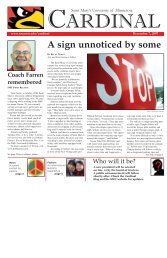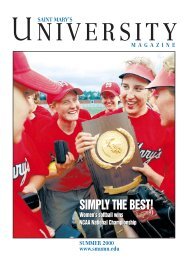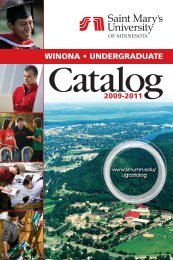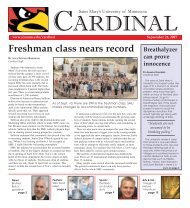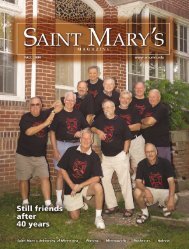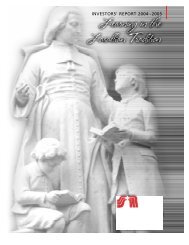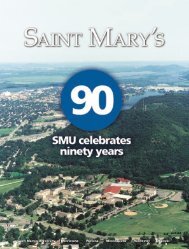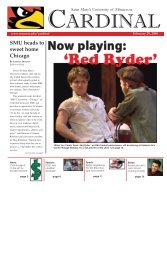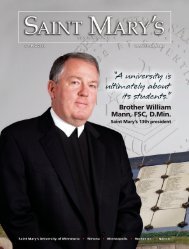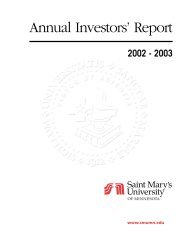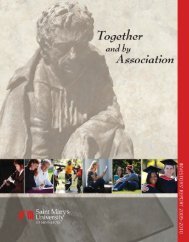& Student Handbook - Saint Mary's University of Minnesota
& Student Handbook - Saint Mary's University of Minnesota
& Student Handbook - Saint Mary's University of Minnesota
Create successful ePaper yourself
Turn your PDF publications into a flip-book with our unique Google optimized e-Paper software.
Master Degree Programs 199<br />
Master <strong>of</strong> Science in Nurse Anesthesia<br />
The Master <strong>of</strong> Science in Nurse Anesthesia program is for qualified<br />
Registered Nurses who wish to earn a Master <strong>of</strong> Science degree while<br />
pursuing education as a Certified Registered Nurse Anesthetist. The<br />
objective <strong>of</strong> the program is to prepare nurses for positions <strong>of</strong> leadership<br />
on the healthcare team.<br />
<strong>Saint</strong> Mary’s <strong>University</strong> believes in building and developing on the<br />
baccalaureate base with emphasis on a strong scientific and technical<br />
background. Graduates will be prepared to practice in a wide variety <strong>of</strong><br />
settings and in diverse methods <strong>of</strong> administering a safe anesthetic. The<br />
graduate is eligible to write the certification examination as <strong>of</strong>fered by<br />
the Council on Certification <strong>of</strong> Nurse Anesthestists. Succesful<br />
completion <strong>of</strong> the examination entitles the graduate to be known as a<br />
Certified Registered Nurse Anesthetist.<br />
Program Outcomes<br />
1. Demonstrate the ability to provide safe and competent care<br />
throughout the perianesthetic continuum.<br />
2. Demonstrate critical thinking skills.<br />
3. Communicate effectively.<br />
4. Demonstrate pr<strong>of</strong>essional behavior.<br />
5. Continue to learn throughout their careers.<br />
Clinical Outcome<br />
Objectives<br />
Patient safety is demonstrated by the ability <strong>of</strong> the student to do the<br />
following:<br />
1. Be vigilant in the delivery <strong>of</strong> patient care.<br />
2. Protect patients from iatrogenic complications.<br />
3. Participate in the positioning <strong>of</strong> patients to prevent injury.<br />
4. Conduct a comprehensive and appropriate equipment check.<br />
5. Utilize standard precautions and appropriate infection control measures.<br />
Individualized perianesthetic management is demonstrated by the ability<br />
<strong>of</strong> the student to do the following:<br />
1. Provide care throughout the perianesthetic continuum.<br />
2. Use a variety <strong>of</strong> current anesthesia techniques, agents, adjunctive<br />
drugs, and equipment while providing anesthesia.<br />
3. Administer general anesthesia to patients <strong>of</strong> all ages and physical<br />
conditions for a variety <strong>of</strong> surgical and medically related procedures.<br />
4. Provide anesthesia services to all patients, including trauma and<br />
emergency cases.<br />
5. Administer and manage a variety <strong>of</strong> regional anesthetics.<br />
6. Function as a resource person for airway and ventilatory<br />
management <strong>of</strong> patients.<br />
7. Possess current advanced cardiac life support (ACLS) recognition.<br />
8. Possess current pediatric advanced life support (PALS) recognition.<br />
9. Deliver culturally competent perianesthetic care throughout the<br />
anesthesia experience.<br />
Critical thinking is demonstrated by the student's ability to do the following:<br />
1. Apply theory to practice in decision-making and problem-solving.<br />
2. Provide nurse anesthesia care based on sound principles and<br />
research evidence.<br />
3. Perform a preanesthetic assessment and formulate an anesthesia care<br />
plan for patients to whom they are assigned to administer anesthesia.<br />
4. Identify and take appropriate action when confronted with anesthetic<br />
equipment-related malfunctions.<br />
5. Interpret and utilize data obtained from noninvasive and invasive<br />
monitoring modalities.<br />
6. Calculate, initiate, and manage fluid and blood component therapy.<br />
7. Recognize and appropriately respond to anesthetic complications<br />
that occur during the perianesthetic period.<br />
8. Pass the Council on Certification <strong>of</strong> Nurse Anesthetists’ certification<br />
examination.<br />
Communication skills are demonstrated by the student's ability to do the<br />
following:<br />
1. Effectively communicate with all individuals influencing patient care.<br />
2. Interact competently with a diverse population.<br />
3. Utilize appropriate verbal, nonverbal, and written communication in<br />
the delivery <strong>of</strong> perianesthetic care.<br />
4. Communicate effectively through case records, written reports and<br />
pr<strong>of</strong>essional papers.<br />
Pr<strong>of</strong>essional role is demonstrated by the student's ability to do the following:<br />
1. Demonstrate ethical behavior when interacting with patients, affiliated<br />
healthcare associations and members <strong>of</strong> the medical community.<br />
2. Participate in activities that improve anesthesia care.<br />
3. Function within appropriate legal requirements as a registered<br />
pr<strong>of</strong>essional nurse, accepting responsibility and accountability for his<br />
or her practice.<br />
4. Interact on a pr<strong>of</strong>essional level with integrity.<br />
5. Teach others.<br />
6. Participate in continuing education activities to acquire new<br />
knowledge and improve his or her practice.<br />
Program Philosophy<br />
The Master <strong>of</strong> Science program in Nurse Anesthesia originated in<br />
response to the request <strong>of</strong> leaders in healthcare for graduate level<br />
education in the field <strong>of</strong> Nurse Anesthesia. With this need in mind, <strong>Saint</strong><br />
Mary’s <strong>University</strong> <strong>of</strong> <strong>Minnesota</strong> developed this program in affiliation with<br />
Abbott Northwestern Hospital. With a focus on meeting the needs <strong>of</strong><br />
adult learners, the program’s goal is to provide a positive and supportive<br />
learning environment, preparing the pr<strong>of</strong>essional nurse in the art and



